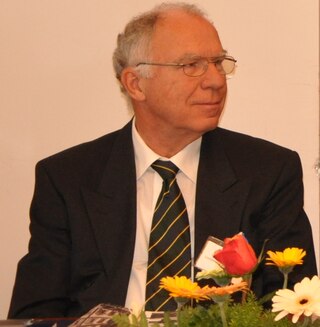
Machine translation is use of either rule-based or probabilistic machine learning approaches to translation of text or speech from one language to another, including the contextual, idiomatic and pragmatic nuances of both languages.

Wiktionary is a multilingual, web-based project to create a free content dictionary of terms in all natural languages and in a number of artificial languages. These entries may contain definitions, images for illustration, pronunciations, etymologies, inflections, usage examples, quotations, related terms, and translations of terms into other languages, among other features. It is collaboratively edited via a wiki. Its name is a portmanteau of the words wiki and dictionary. It is available in 192 languages and in Simple English. Like its sister project Wikipedia, Wiktionary is run by the Wikimedia Foundation, and is written collaboratively by volunteers, dubbed "Wiktionarians". Its wiki software, MediaWiki, allows almost anyone with access to the website to create and edit entries.

A parallel text is a text placed alongside its translation or translations. Parallel text alignment is the identification of the corresponding sentences in both halves of the parallel text. The Loeb Classical Library and the Clay Sanskrit Library are two examples of dual-language series of texts. Reference Bibles may contain the original languages and a translation, or several translations by themselves, for ease of comparison and study; Origen's Hexapla placed six versions of the Old Testament side by side. A famous example is the Rosetta Stone, whose discovery allowed the Ancient Egyptian language to begin being deciphered.
A paraphrase or rephrase is the rendering of the same text in different words without losing the meaning of the text itself. More often than not, a paraphrased text can convey its meaning better than the original words. In other words, it is a copy of the text in meaning, but which is different from the original. For example, when someone tells a story they heard in their own words, they paraphrase, with the meaning being the same. The term itself is derived via Latin paraphrasis, from Ancient Greek παράφρασις (paráphrasis) 'additional manner of expression'. The act of paraphrasing is also called paraphrasis.
Linguistic categories include
Various methods for the evaluation for machine translation have been employed. This article focuses on the evaluation of the output of machine translation, rather than on performance or usability evaluation.
Language resource management – Lexical markup framework, produced by ISO/TC 37, is the ISO standard for natural language processing (NLP) and machine-readable dictionary (MRD) lexicons. The scope is standardization of principles and methods relating to language resources in the contexts of multilingual communication.
Ega, also known as Egwa and Diès, is a West African language spoken in south-central Ivory Coast. It is of uncertain affiliation and has variously been classified as Kwa or an independent branch of Niger-Congo.
The German Reference Corpus is an electronic archive of text corpora of contemporary written German. It was first created in 1964 and is hosted at the Institute for the German Language in Mannheim, Germany. The corpus archive is continuously updated and expanded. It currently comprises more than 4.0 billion word tokens and constitutes the largest linguistically motivated collection of contemporary German texts. Today, it is one of the major resources worldwide for the study of written German.
Interactive machine translation (IMT), is a specific sub-field of computer-aided translation. Under this translation paradigm, the computer software that assists the human translator attempts to predict the text the user is going to input by taking into account all the information it has available. Whenever such prediction is wrong and the user provides feedback to the system, a new prediction is performed considering the new information available. Such process is repeated until the translation provided matches the user's expectations.
The LRE Map is a freely accessible large database on resources dedicated to Natural language processing. The original feature of LRE Map is that the records are collected during the submission of different major Natural language processing conferences. The records are then cleaned and gathered into a global database called "LRE Map".
Deep Linguistic Processing with HPSG - INitiative (DELPH-IN) is a collaboration where computational linguists worldwide develop natural language processing tools for deep linguistic processing of human language. The goal of DELPH-IN is to combine linguistic and statistical processing methods in order to computationally understand the meaning of texts and utterances.
LEPOR is an automatic language independent machine translation evaluation metric with tunable parameters and reinforced factors.
Glottolog is a free online bibliographic database of the world's languages. In addition to listing linguistic materials describing individual languages, the database also contains the most up-to-date language affiliations based on the work of expert linguists.
NooJ is a linguistic development environment software as well as a corpus processor constructed by Max Silberztein. NooJ allows linguists to construct the four classes of the Chomsky-Schützenberger hierarchy of generative grammars: Finite-State Grammars, Context-Free Grammars, Context-Sensitive Grammars as well as Unrestricted Grammars, using either a text editor, or a Graph editor.
UBY is a large-scale lexical-semantic resource for natural language processing (NLP) developed at the Ubiquitous Knowledge Processing Lab (UKP) in the department of Computer Science of the Technische Universität Darmstadt . UBY is based on the ISO standard Lexical Markup Framework (LMF) and combines information from several expert-constructed and collaboratively constructed resources for English and German.
The EuroMatrix is a project that ran from September 2006 to February 2009. The project aimed to develop and improve machine translation (MT) systems between all official languages of the European Union (EU).

Joseph Mariani is a French computer science researcher and pioneer in the field of speech processing.

Walther von Hahn is a German linguist and computer scientist. From 1977 to 2007, von Hahn taught Computer Science and Linguistics at Universität Hamburg.
In linguistics and language technology, a language resource is a "[composition] of linguistic material used in the construction, improvement and/or evaluation of language processing applications, (...) in language and language-mediated research studies and applications."




